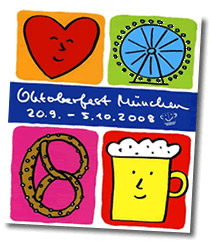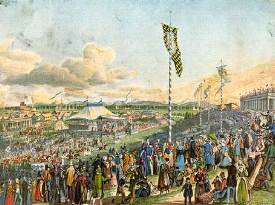|
Oktoberfest in Munich
2006: Sept. 20-Oct. 5
 Oktoberfest in Munich is the biggest public festival in the world. This year's celebration, the 174nd (some were canceled because of wars and cholera outbreaks), will begin Sept. 20 and end Oct. 5. About 6 million visitors are expected to consume more than 6 million liters of beer. Oktoberfest in Munich is the biggest public festival in the world. This year's celebration, the 174nd (some were canceled because of wars and cholera outbreaks), will begin Sept. 20 and end Oct. 5. About 6 million visitors are expected to consume more than 6 million liters of beer.
At the foot of the Bavaria statue, the huge Oktoberfest grounds also provide carousels, roller coasters and all the spectacular fun of the fair. Activities are accompanied by a program of events, including the Grand Entry of the Oktoberfest Landlords and Breweries, the Costume and Riflemen's Procession, and a concert involving all the brass bands represented at the "Wiesn".
Dates and times to remember
Sept. 20, 10:45 a.m.: Grand Entry of the Oktoberfest Landlords and Breweries.
Sept. 20, noon: The famous "O'ZAPFT IS" (it's been tapped): Munich mayor taps the first keg of beer."It's tapped!"
Sept. 21, 10 a.m.: Oktoberfest Costume and Riflemen's Parade.
Sept. 28, 11 a.m.: Oktoberfest bands: 400 musicians at at the foot of the Bavaria statue.
Drinking hours
Opening day noon-10:30 p.m.
Weekdays 10 a.m-10:30 p.m.
Saturday, Sunday & holiday 9 a.m-10:30 p.m.
Daily closing hour 11:30 p.m.
"K�fers Wiesnsch�nke" and "Weinzelt"
open until 1 a.m., last drinks at 12:15 a.m
Sales stands
Opening day 10 a.m-midnight
Monday - Thursday 10 a.m-11:30 p.m.
Friday 10.00 a.m-midnight
Saturdays 9 a.m-midnight
Sundays 9 a.m-11:30 p.m
Fairground attractions & sideshows
Opening day noon - midnight
Monday - Thursday 10 a.m-11:30 p.m.
Friday 10 a.m - midnight
Saturdays 10 a.m - midnight
Sundays 10 a.m - 11.30 p.m
How it began
 Crown Prince Ludwig, later to become King Ludwig I, was married to Princess Therese of Saxony-Hildburghausen on Oct. 12, 1810. The citizens of Munich were invited to attend the festivities held on the fields in front of the city gates. The fields have been named Theresienwiese ("Theresa's fields") in honor of the Crown Princess ever since. Horse races marked the close of the event. The decision to repeat the horse races in the subsequent year gave rise to the tradition of the Oktoberfest. Crown Prince Ludwig, later to become King Ludwig I, was married to Princess Therese of Saxony-Hildburghausen on Oct. 12, 1810. The citizens of Munich were invited to attend the festivities held on the fields in front of the city gates. The fields have been named Theresienwiese ("Theresa's fields") in honor of the Crown Princess ever since. Horse races marked the close of the event. The decision to repeat the horse races in the subsequent year gave rise to the tradition of the Oktoberfest.
The first Agricultural Show was added in 1811. The horse races, which were the oldest and - at one time - the most popular event of the festival are no longer held today. But the Agricultural Show is still held every three years during the Oktoberfest.
About the beer
Visitors in the early years were able to quench their thirst at small beer stands which grew rapidly in number. In 1896 the beer stands were replaced by the first beer tents and halls set up by enterprising landlords with the backing of the breweries.
Today there are 14 large beer tents. About 30% of the year's beer-production of the big breweries in Munich are drunk during these two weeks. The estimated beer price will range between 7.7 and 8 Euros per liter.
And getting it 'delivered'
About 1,600 of the 12,000 people employed at Oktoberfest are particularly famous - the waitresses who deliver the beer. They are between 18 and 80 and work long hours, hauling up to 10 steins at a time (usually 40-60 pounds), each full of a liter of beer, through rowdy crowds.
Tips are generous, because of a special Oktoberfest currency - the beer coupon. Company bosses treat employees, business owners, their regular clients and the city's senior citizens to the printed cardboard currency.
By the numbers
The official festival area covers 104 acres and has seating for 94,000 in the festival halls.
The festival grounds has about 1,440 toilets.
About 900 tons of waste will be generated during Oktoberfest.
The 2007 festival drew 6.2 million visitors. They consumed 6.7 million liters of beer and 200,000 liters of non-alcoholic beer.
Food consumption included 104 oxen, 56,036 pork knuckles, 487,487 chickens and 190,635 pairs of pork sausage.
In contrast, 1950 more than 1.5 million liters of beer was drunk and nearly 650,000 pairs of sausage eaten. 1970, the numbers had grown to nearly 4 million liters of beer and 800,000 pairs of sausage. While total (if not per capita) beer consumption has continued to rise, sausage sales have fallen dramatically.
|

